As a homeowner in Boston’s vibrant and historic city, you understand the importance of preserving your property against the diverse and sometimes unpredictable New England weather. Your roof, in particular, is a crucial line of defense against rain, snow, and all that Mother Nature throws its way. To ensure the longevity and functionality of your roofing system, following a comprehensive maintenance checklist is essential.
In this guide, we’ll walk you through the key steps Boston homeowners should take to prevent potential issues and extend the life of their roofs.
1. Regular Inspections
The first line of defense in maintaining a healthy roof is regular inspections. Conduct thorough checks at least twice a year, preferably in the spring and fall. Look for signs of damage, such as missing or damaged shingles, sagging areas, or visible wear and tear. Pay close attention to areas around chimneys, vents, and skylights, as these are common trouble spots.
Regular inspections by Professional Boston Roofers not only allow you to catch minor issues before they escalate but also provide an opportunity to assess the overall condition of your roof. Document any changes or concerns during each inspection, creating a timeline of your roof’s health.
For those seeking expert assistance in executing these crucial tasks, trusted Boston roofers at 234 West Newton St #2, Boston, MA 02116, stand ready to lend their expertise.
2. Clean Gutters and Downspouts
Boston experiences its fair share of rain and snow, making proper drainage crucial. Clogged gutters can lead to water pooling on the roof, which may cause leaks and structural damage. Clean ditches and downspouts regularly, removing leaves, debris, and any other obstructions that could impede water flow.
Consider investing in gutter guards to minimize debris buildup and reduce the frequency of cleanings. Proper drainage protects your roof and helps preserve the integrity of your home’s foundation by directing water away from the building.
3. Trim Overhanging Branches
Overhanging branches deposit leaves and debris on your roof and pose a risk of falling during storms. Trim back branches to prevent them from scraping against the roof and causing damage. This simple step can also minimize the risk of pests, like squirrels, gaining access to your home.
Beyond roof protection, trimming branches enhances the aesthetic appeal of your property and contributes to a safer environment. Addressing overhanging branches promptly prevents potential hazards and extends the life of your roofing materials.
4. Check for Moss and Algae
Boston’s climate can create an environment conducive to the growth of moss and algae on your roof. While they may seem harmless, these can lead to deterioration of roofing materials over time. Use a gentle cleaning solution and a soft brush to remove moss or algae growth.
The presence of moss and algae not only affects the appearance of your roof but can also compromise its structural integrity. Regular cleaning not only maintains the visual appeal of your home but also protects your investment by preventing long-term damage.
5. Inspect Flashing and Seals
The flashing around chimneys, vents, and skylights is crucial for preventing water infiltration. Inspect these areas for signs of damage or deterioration, and replace any damaged flashing promptly. Additionally, check the seals around these openings to ensure they are intact and provide a watertight barrier.
Properly maintained flashing and seals are essential components of a leak-free roof. Addressing issues promptly during inspections prevents water from seeping into your home, preserving the integrity of your roof and interior spaces.
6. Examine Attic Ventilation
Proper attic ventilation is essential for preventing moisture buildup and maintaining a consistent temperature in your home. Check for signs of inadequate ventilation, such as mold growth, and ensure that vents are clear of obstructions. Adequate ventilation can also contribute to energy efficiency by regulating indoor temperatures.
A well-ventilated attic not only protects your roof from potential issues like rot and mold but also contributes to the overall health of your home. Addressing ventilation concerns during inspections enhances the lifespan of your roof and the comfort of your living spaces.
7. Inspect Insulation
The insulation in your attic is crucial in maintaining a comfortable and energy-efficient home. Inspect the insulation for signs of damage, moisture, or pest infestations. Replace or repair damaged insulation promptly to prevent heat loss and ice dams.
In addition to protecting your roof, well-maintained insulation contributes to energy savings and a more comfortable living environment. Regular inspections allow you to identify and address insulation concerns before they escalate, ensuring optimal performance and efficiency.
8. Address Ice Dams
Boston’s winters can bring heavy snowfall, leading to the formation of ice dams on roofs. Ice dams can cause water backup and damage to shingles and structural components. Use a roof rake to remove excess snow, and consider improving insulation and ventilation to prevent ice dams from forming.
Proactive measures to address ice dams protect your roof and prevent potential water damage to your home’s interior. Regular checks and timely interventions during winter are essential for mitigating the risks associated with heavy snowfall and freezing temperatures.
9. Look for Signs of Leaks Inside
Regularly inspect your ceilings and walls for signs of water damage, such as discoloration or peeling paint. Address any leaks promptly to prevent further damage to your roof and interior.
Interior inspections complement external checks, providing a comprehensive view of your roof’s condition. Timely identification and repair of leaks safeguard your roofing system and your home’s structural integrity and interior spaces.
10. Schedule Professional Inspections
While regular homeowner inspections are crucial, scheduling professional inspections at least once a year is also essential. Experienced roofers can identify issues that may not be apparent to the untrained eye and provide expert recommendations for maintenance and repairs.
Professional inspections offer an added layer of assurance, ensuring that your roof repair receives a thorough examination by trained experts. Roofing professionals can detect potential problems early, providing the opportunity for proactive maintenance that can significantly extend the lifespan of your roofing system.
End Note
By following this comprehensive roofing maintenance checklist, Boston homeowners can take proactive steps to protect their investment and ensure the longevity of their roofs. Regular inspections, proper cleaning, and prompt repairs are crucial to preventing potential issues and maintaining a resilient roof that can withstand the varied weather conditions of this historic city. Remember, a well-maintained roof not only enhances your home’s curb appeal but also provides peace of mind, knowing that you’ve taken the necessary steps to safeguard your property against the elements. Regular attention to your roof’s health will pay off in the long run, preserving the integrity of your home and ensuring a safe and comfortable living environment for years to come.













